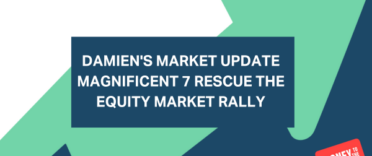The 146th episode of my weekly YouTube show where I discuss what is happening in investment markets and what to look out for. This week I talk about equity market and bond yield breakouts.
Each show lasts between 5-10 minutes and is aimed at DIY investors (including novices) seeking contemporary analysis to help them understand how investment markets work.
Subscribe to my YouTube channel to receive my weekly analysis of investment markets or alternatively, you can listen via my weekly Midweek Markets podcast below.
Midweek Markets weekly podcast
Other ways to watch, listen and subscribe
You can listen to other episodes and subscribe to the show by searching 'Money to the Masses' on Spotify or by using the following links:
Abridged transcript - Midweek Markets episode 146
Last week I spoke about how markets were stalling, with the equity rebound in danger of running out of steam. In particular, I focussed on the DAX and the S&P 500, highlighting key levels of resistance on each index that were proving tough to break through. If you recall a resistance line, from a technical analysis point of view, is a level/price that an asset or index has trouble breaking above. Last week I explained that the line of resistance to watch on the S&P 500 was 4500, while the DAX was struggling with 14,500. I also mentioned that if either threshold was breached to the upside then the rebound will likely have further to run. Furthermore both these levels were just above their respective index’s 200 day moving average.
After a number of attempts, both indices finally broke above these lines of resistance, with the S&P 500 currently sitting at 4600, after bursting higher once 4500 gave way. Meanwhile, the German DAX sits just above 14,600, having been as high as almost 14,900 after its own breakout. So is that it, is the bear market over?
Of course, it’s a brave person that makes such bold statements as investment markets have a way of humbling you. But what is not in doubt is that the weight of technical evidence suggesting that the market has turned a corner is growing, even if it’s not conclusive yet. The S&P 500 has broken out of a downtrend that started on 3rd January, and has now broken above its 200 day moving average which sits at 4482. The buy the dip mentality has returned to US stock markets and the Nasdaq 100 has enjoyed one of the best 10 day streaks in its recent history. Since mid-March the index is up 15%, which brings the year to date loss down to -8%.
The German DAX is attempting a similar breakout to that which we are seeing on the S&P 500. If it holds then it will be positive for the index. Yet most of the equity market moves don’t make sense from a fundamental point of view. After all, the war in Ukraine is ongoing, despite positive news headlines about possible Russian troop withdrawals and constructive peace talks. Not only that, but central banks in the UK, US and Europe are tightening monetary policy. In the case of the US Federal Reserve the market has been told that the pace of these hikes will likely be aggressive, yet equity markets seem unfazed. In past shows I’ve often highlighted bitcoin as a good indicator of investor risk appetite, and the digital currency has rallied 25% since its mid-March low and sits at $47,300. This is also partly a reflection of the rally in tech stocks.
But while equity investors are prepared to look beyond the Fed tightening phase the bond market is still not. The 10 years US treasury yield currently sits at 2.33%, having reached as high as 2.5% in the last week. It means that the yield has broken out of a downtrend that started almost 30 years ago. This could be significant if the trend continues. Unsurprisingly, as March draws to a close we are looking at the worst quarter for bonds markes (in particularly US treasuries) since 1973.
It is worth noting that the downtrend in bond yields has been tested numerous times over the last 30 years, most recently in 2019 before bond yields collapsed, sending the value of bond funds higher as fears of a recession were increasing. When the pandemic hit, equity markets collapsed and the fall in bond yields accelerated. Those who didn’t turned their backs on bonds were rewarded. It raises the question, will this time really be any different? Or are bonds really now in some form of death spiral caused by rising inflation and central bank tightening?
The volatlity in bond markets has also picked up significantly in recent weeks, while at the same time the S&P 500’s VIX (the fear gauge) has tumbled back below its long term average of 20. That in itself is very unusual and historically we often see equity market volatility pick up in response whenever this divergence occurs. If that happens it means we are likely to see equity markets react negatively. But for now equity investors are ignoring what the bond market is telling them, instead sticking their fingers in their ears and cherry picking the bits of information that they want to hear. For example, the yield on the 2 year US treasury rose above the yield on the 10 year US treasury this week, for the first time since 2019. This yield curve inversion is a closely watched recession indicator, but equity markets remain unfazed by the potential for a recession. Equity investors also seem to be looking beyond future Fed rate rises and focusing on the bond market’s suggestion of potential interest rate cuts in for 2023 or 2024, after the Fed tightens too much too fast and makes a policy mistake. Any hint that central banks may support the market, has caused equity markets to rally in response, not matter how far off in the future that may be.
In the coming weeks we will find out whether the breakouts in equity markets and bond yields markets will hold. Equity markets will soon have to navigate another corporate earnings season which will include the impact of the war in Ukraine on corporate profits. This could be a headwind, and given that most equity markets are only 5-10% below their recent or all-time highs it’s unlikely that the situation in Ukraine has been accounted for in valuations so far. With so much uncertainty its pays to go back to technicals to make sense of the noise. For the S&P 500, 4500 remains an important area for the index to remain above if the rebound is to continue. For the DAX the equivalent level is still 14500. In bond markets, the 2.2% level on the 10 year US treasury is important. If we drop back below there (which means bonds are rising in value) then the multi-decade downtrend in bonds will likely resume as it did in 2019, when recessionary fears last began to emerge. There are clearly a number of parallels to be drawn between late 2019 and now but let’s hope that the meniotned similarities end there, because a few months later most equity markets entered a bear market in 2020, although admittedly as a result of the pandemic.



